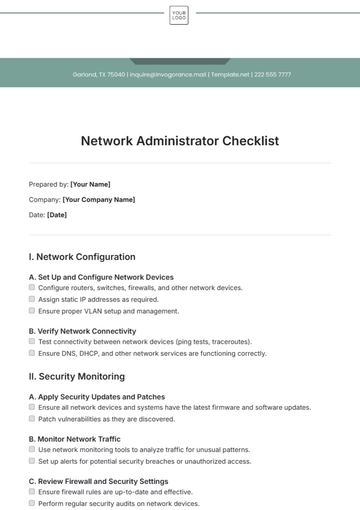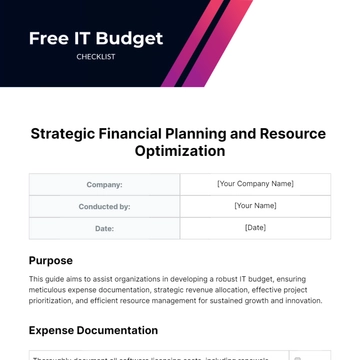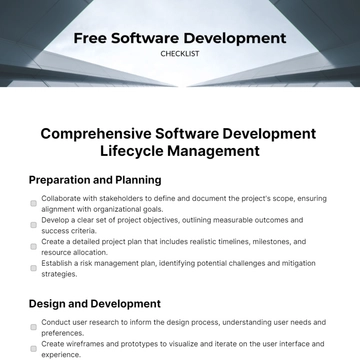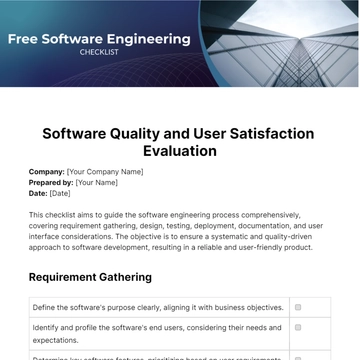Free Software Engineering Checklist
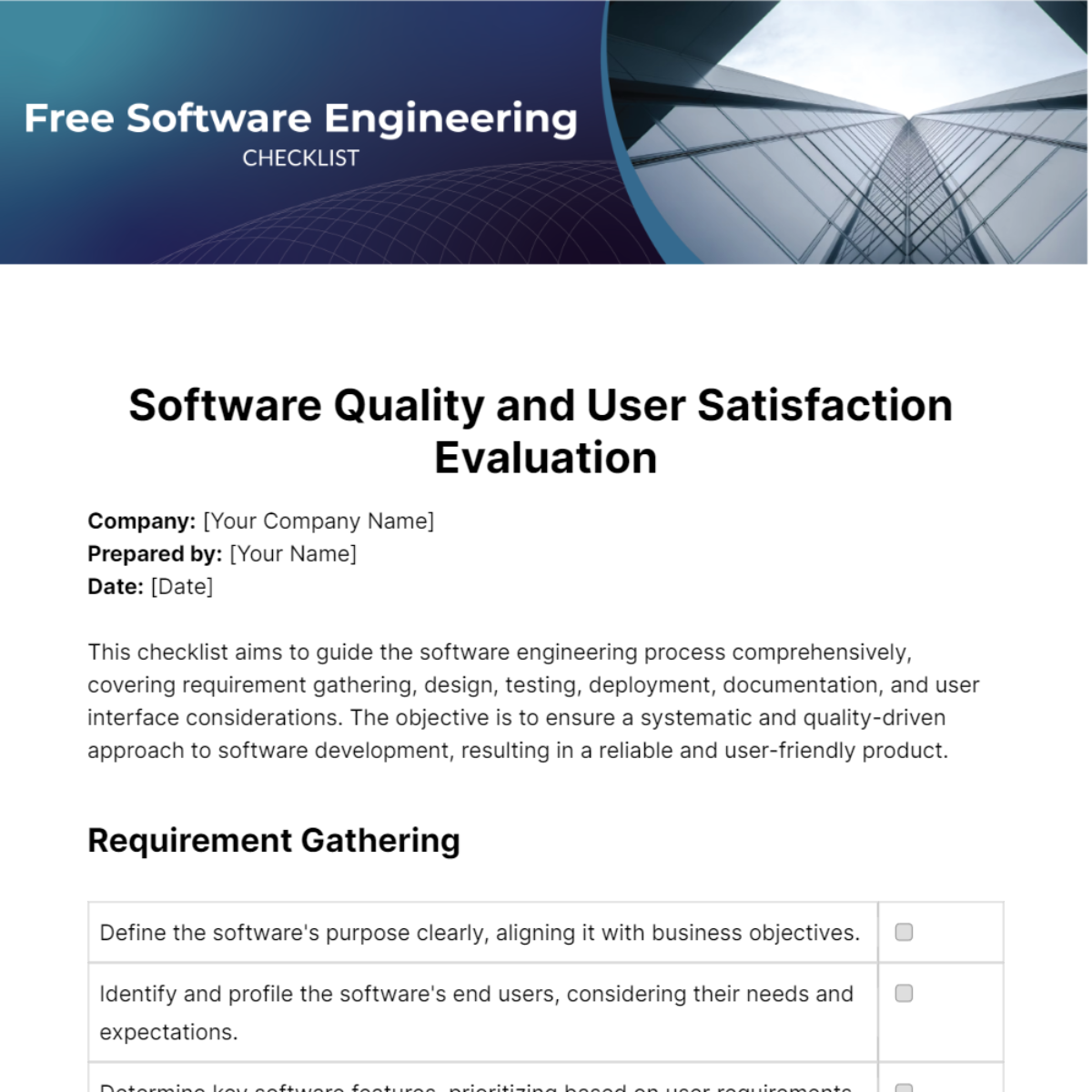
Company: [Your Company Name]
Prepared by: [Your Name]
Date: [Date]
This checklist aims to guide the software engineering process comprehensively, covering requirement gathering, design, testing, deployment, documentation, and user interface considerations. The objective is to ensure a systematic and quality-driven approach to software development, resulting in a reliable and user-friendly product.
Requirement Gathering
Define the software's purpose clearly, aligning it with business objectives. | |
Identify and profile the software's end users, considering their needs and expectations. | |
Determine key software features, prioritizing based on user requirements. | |
Define performance requirements, specifying response times and resource utilization thresholds. |
Design
Develop a robust architectural design, ensuring scalability and flexibility. | |
Create an intuitive user interface design, focusing on usability and accessibility. | |
Design a well-organized and efficient database structure. | |
Construct modular software components, promoting maintainability and reusability. |
Testing
Develop a comprehensive test plan, covering functional and non-functional aspects. | |
Perform thorough unit testing to validate individual module functionalities. | |
Conduct integration testing to ensure seamless interaction between modules. | |
Execute systematic system testing to validate the overall system behavior. |
Deployment
Prepare a detailed deployment plan, considering rollback strategies and contingencies. | |
Coordinate closely with the client for deployment schedules and requirements. | |
Deploy the software on the live environment, monitoring and resolving deployment issues promptly. |
Documentation
Create user manuals for end-users, providing step-by-step guidance. | |
Prepare detailed technical documentation for developers and administrators. | |
Develop a troubleshooting guide, addressing common issues and resolutions. | |
Regularly update all design and test documentations to reflect the current system state. |
User-friendly Interface
Design intuitive and consistent interfaces, enhancing user experience. | |
Ensure compatibility on multiple platforms, catering to diverse user environments. | |
Implement effective user feedback mechanisms for continuous improvement. | |
Optimize for speed and performance, prioritizing a responsive user interface. |
- 100% Customizable, free editor
- Access 1 Million+ Templates, photo’s & graphics
- Download or share as a template
- Click and replace photos, graphics, text, backgrounds
- Resize, crop, AI write & more
- Access advanced editor
Introducing the Software Engineering Checklist Template on Template.net – your go-to solution for streamlined development workflows. This editable and customizable checklist ensures precision in every project. Seamlessly modify tasks using our very own Ai Editor Tool, empowering your team with unparalleled efficiency. Elevate your software engineering process with this indispensable resource.
You may also like
- Cleaning Checklist
- Daily Checklist
- Travel Checklist
- Self Care Checklist
- Risk Assessment Checklist
- Onboarding Checklist
- Quality Checklist
- Compliance Checklist
- Audit Checklist
- Registry Checklist
- HR Checklist
- Restaurant Checklist
- Checklist Layout
- Creative Checklist
- Sales Checklist
- Construction Checklist
- Task Checklist
- Professional Checklist
- Hotel Checklist
- Employee Checklist
- Moving Checklist
- Marketing Checklist
- Accounting Checklist
- Camping Checklist
- Packing Checklist
- Real Estate Checklist
- Cleaning Checklist Service
- New Employee Checklist
- Food Checklist
- Home Inspection Checklist
- Advertising Checklist
- Event Checklist
- SEO Checklist
- Assessment Checklist
- Inspection Checklist
- Baby Registry Checklist
- Induction Checklist
- Employee Training Checklist
- Medical Checklist
- Safety Checklist
- Site Checklist
- Job Checklist
- Service Checklist
- Nanny Checklist
- Building Checklist
- Work Checklist
- Office Checklist
- Training Checklist
- Website Checklist
- IT and Software Checklist
- Performance Checklist
- Project Checklist
- Startup Checklist
- Education Checklist
- Home Checklist
- School Checklist
- Maintenance Checklist
- Planning Checklist
- Manager Checklist
- Wedding Checklist
- Vehicle Checklist
- Travel Agency Checklist
- Vehicle Inspection Checklist
- Interior Design Checklist
- Backpacking Checklist
- Business Checklist
- Legal Checklist
- Nursing Home Checklist
- Weekly Checklist
- Recruitment Checklist
- Salon Checklist
- Baby Checklist
- Equipment Checklist
- Trade Show Checklist
- Party Checklist
- Hospital Bag Checklist
- Evaluation Checklist
- Agency Checklist
- First Apartment Checklist
- Hiring Checklist
- Opening Checklist
- Small Business Checklist
- Rental Checklist
- College Dorm Checklist
- New Puppy Checklist
- University Checklist
- Building Maintenance Checklist
- Work From Home Checklist
- Student Checklist
- Application Checklist
